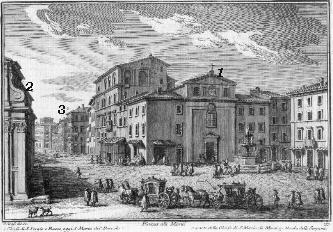  Piazza alli Monti (Book 2) (Day 3) (Rione Monti) In this page:
Via dei Serpenti was called il Corso dei Monti, what today we would
call the high street of Rione Monti, the old Suburra of Rome. The church
of S. Maria ai Monti is shown in plate 169 - Collegio
de' Neofiti. The view is taken from the green dot in the 1748 map here below. In the description below the plate Vasi made reference
to: 1) Chiesa dei SS. Sergio e Bacco; 2) S. Maria ai Monti; 3) Via dei Serpenti. The small map shows also 4)
Piazza degli Zingari; 5) Casa Stefanoni; 6) S. Salvatore ad tres images; 7) Cappella di S. Giuseppe Benedetto Labre.
Today Via dei Serpenti and the neighboring area is cut from the main
traffic flow due to the opening of Via Nazionale and Via Cavour. The grand
street and the large piazza of the plate are just an excessive adjustment
to reality by Vasi.
The fountain was built during the pontificate of Sixtus V (lower right corner). The small church was restored by Leo XIII (upper right corner). The column surrounded by flames is a symbol of unscathed faith (it can be seen also in S. Basilio). It is a church for the Catholics of Eastern Europe. It was also called S. Maria del Pascolo. Cappella di S. Benedetto Giuseppe Labre
On April 16, 1783 Benedict Joseph Labre, a French monk who was leading a very
penitential life in the streets of Rome, sleeping on the ground and eating very little, lost consciousness on the steps
of S. Maria ai Monti. He was brought to a house belonging to the Portuguese church of S. Antonio, where
he passed away that same day. Later on the room where he died was transformed into a small chapel (more on him).
The area around Piazza alli Monti retains some elegant XVIIIth century buildings: the image shows
from left to right the windows of a building in Piazza degli Zingari and a fountain in Casa Stefanoni.
Next plate in Book 2: Piazza di Colonna Trajana Next step in Day 3 itinerary: Chiesa e Monastero di S. Lorenzo in Panisperna Next step in your tour of Rione Monti: Chiesa e Monastero di S. Lorenzo in Panisperna
Go
to |







